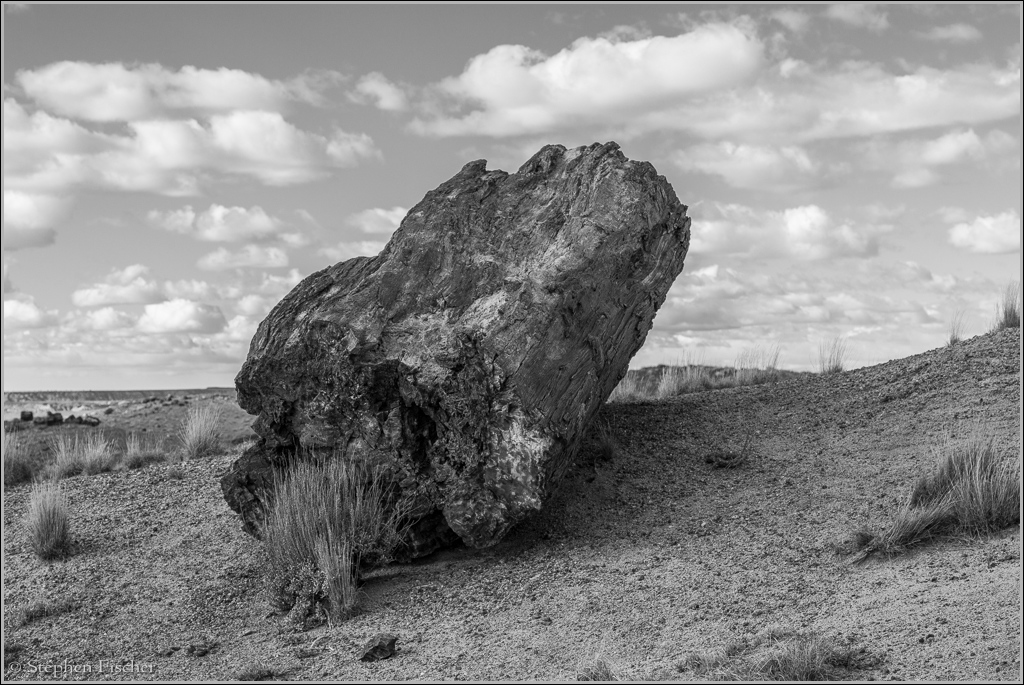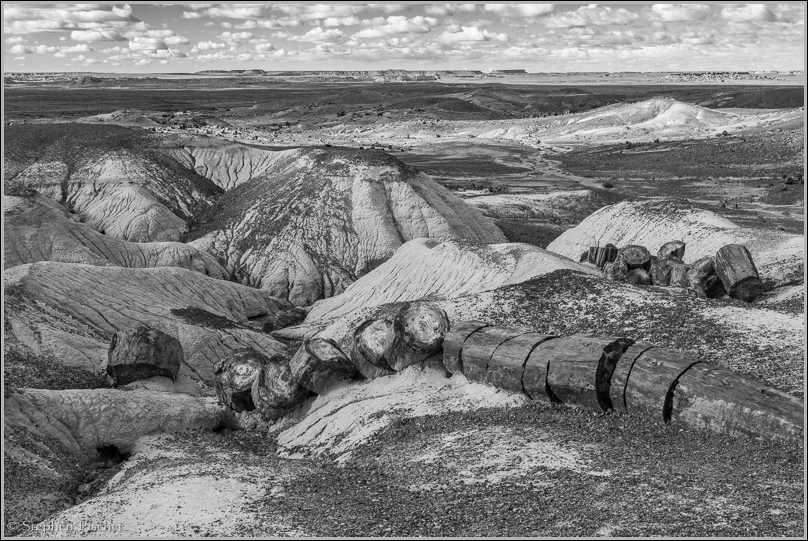Picture of the week
| Previous weeks |
 Jan
1, 2017 Jan
1, 2017 |
 Dec
18, 2016 Dec
18, 2016 |
 Dec
11, 2016 Dec
11, 2016 |
 Nov
27, 2016 Nov
27, 2016 |
 Nov
13, 2016 Nov
13, 2016 |
 Nov
6, 2016 Nov
6, 2016 |
 Oct
16, 2016 Oct
16, 2016 |
 Sept
25, 2016 Sept
25, 2016 |
 Sept
18, 2016 Sept
18, 2016 |
 Sept
4, 2016 Sept
4, 2016 |
 Aug
21, 2016 Aug
21, 2016 |
| Older |

Prehistoric Log
Remains of a petrified tree of the Petrified Forest National Park in Arizona. Yep, it is just a piece of wood on some dirt. Albiet over 200 million years, with the original wood pulp of this prehistoric tree replaced by minerals of silica (e.g. quartz).
Rendered in black and white to better emphasize the textures and starkness of this landscape. It is quite a facinating area to see so many of these petrified remains out in the open, exposed to the elements, and somehow still on the surface for all to see. I wonder why such fossils are not buried deep within lower layers of the sedimentary rock? Despite dating back to the Triassic Period of over 200 million years ago, many of these petrified trees are quite recognizeable with by their core, rings, and the outer bark layer. It is surprising to also note that they have retained their original shapes, as if they were just recently transformed to stone, as if given the look by Medusa, and suddently falling over dead.
I visited this location during December while on a photography related road trip through the Four Corners area of the Southwest. The geology of the terrain reminds me of some of the Capital Reef regions I have visited in southern Utah. There is quite a bit of the familiar looking conical shaped layer-cake looking bentonite clay formations that seems have some sort of geological relationship with these petrified trees (e.g. Cathedral Valley). But the concentation of petrified wood itself here is what is most unique and rivals that I have seen anywhere else in the Southwest.
 Given
a limited time budget of less than 2 hours for my visit, I came in from the
south off of US-180 after passing through the town of Holbrook
of Route 66 fame (see the image of the Wigwam motel to the left), and then taking the auto route through the park, before
emptying out again to the north back on I-40. The Crystal Forest
and Jasper Forest closer to the southern entrance tended to have the best
concentration and potential for photography. Some spots off the side
of the road between there and the Rainbow Forest Museum were also of
interest for the bentonite formations, with some time spent exploring a few
areas after parking at some improvised spots off the side of the road.
When I have more time and when in the area again, it would be nice to
explore more of the park, and plan some photography closer to the golden
hour. One just has to be cognizant of the park closing hours to visitors
before 8am and after 5pm.
Given
a limited time budget of less than 2 hours for my visit, I came in from the
south off of US-180 after passing through the town of Holbrook
of Route 66 fame (see the image of the Wigwam motel to the left), and then taking the auto route through the park, before
emptying out again to the north back on I-40. The Crystal Forest
and Jasper Forest closer to the southern entrance tended to have the best
concentration and potential for photography. Some spots off the side
of the road between there and the Rainbow Forest Museum were also of
interest for the bentonite formations, with some time spent exploring a few
areas after parking at some improvised spots off the side of the road.
When I have more time and when in the area again, it would be nice to
explore more of the park, and plan some photography closer to the golden
hour. One just has to be cognizant of the park closing hours to visitors
before 8am and after 5pm.
More images (click to select the larger view at the bottom)



All content and images are property of Stephen Fischer Photography, copyright 2010-2017. Last updated: 1/8/2017 ()